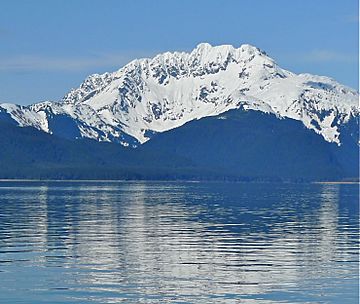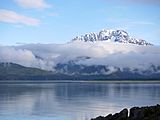Lions Head Mountain facts for kids
Quick facts for kids Lions Head Mountain |
|
|---|---|

Lions Head Mountain, south aspect
|
|
| Highest point | |
| Elevation | 5,400+ ft (1,650+ m) |
| Prominence | 1,200 ft (370 m) |
| Isolation | 1.6 mi (2.6 km) |
| Parent peak | Phoebe (5,552 ft) |
| Geography | |
| Location | Tongass National Forest Juneau Borough Alaska, United States |
| Parent range | Coast Mountains Boundary Ranges Kakuhan Range |
| Topo map | USGS Juneau D-4 |
| Geology | |
| Age of rock | Triassic |
| Type of rock | metabasalt, greenstone |
| Climbing | |
| Easiest route | class 5.0 |
Lions Head Mountain is a cool mountain peak in Alaska, United States. It stands 5,400+ ft (1,650+ m) tall! This mountain is part of the Boundary Ranges within the larger Coast Mountains.
You can find Lions Head Mountain in the Kakuhan Range. It's about 46 mi (74 km) northwest of Juneau. It's also just 3 mi (5 km) east of Lynn Canal. The land around it is managed by the Tongass National Forest.
Even though it's not the tallest mountain, Lions Head Mountain looks very impressive. It rises 5,400 feet straight up from the Berners River Valley in less than three miles! This makes it look very dramatic.
The mountain got its name in 1867 from a geographer named George Davidson. He worked for the U.S. Coast and Geodetic Survey. He thought the mountain's jagged shape looked like a lion lying down, which is called "lion couchant." This name became official in 1929.
Mountain Weather: What to Expect
Lions Head Mountain has a subarctic climate. This means it has very cold, snowy winters. The summers are cool, not hot.
Weather systems from the Gulf of Alaska hit the Coast Mountains. The mountains force the air upwards. This process is called orographic lift. It causes a lot of rain and snow to fall on the mountain.
Temperatures can drop really low, sometimes below -20 °C. With the wind, it can feel even colder, below -30 °C! Because it's so cold, there are even glaciers on the north side of the mountain.
If you want to see or climb Lions Head Mountain, the best time to visit is usually from May through July. The weather is most pleasant then.



